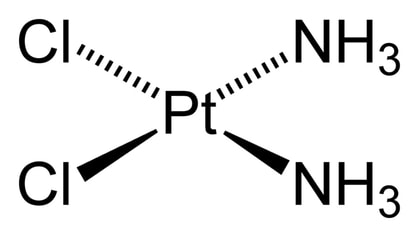 Cisplatin Cisplatin A long time ago an old professor of mine told me a story. He visited a laboratory which recently had started a line of research involving the study of the pancreas. The lab had been doing this for one year and had generated data that was included in a couple of articles they had published. This was one of those labs where the principal investigator was always travelling, teaching classes, or writing grants, so he delegated a lot of the supervisory work to staff scientists. Unfortunately, one of the staff scientists turned out to have lax standards and did not supervise the graduate students and technicians under him a lot. My professor was touring the lab, and he walked by a technician and a student busy at work who told him they were dissecting a mouse’s pancreas for later analysis. However, when he looked closely, my professor was a bit confused. “What is it again that you are doing?” he asked. “We are removing the pancreas from this mouse”, the technician replied. My professor took a deep breath and awkwardly proceeded to inform them that the organ they had just removed was the spleen, not the pancreas. The lab had been working on the wrong organ! Many scientists tend to focus their attention on getting the big things right, but it is often the overlooked little things that can derail a project. An under researched or not very well thought out approach to an experiment, a lack of focus on the procedures, an improperly calibrated piece of equipment, a sloppy experimental methodology, or a not well-supervised lab hand is all it takes to introduce error into the science. And the problem is that the effort to prevent these mistakes from happening is often boring, repetitive, detail-intensive, unglamorous work that some scientists would rather have others do while they instead devote their time to reading, and discussing and thinking exciting and important ideas. Most mistakes, like the one I described at the beginning of this post, involve a few labs and they typically remain within the realm of the anecdote. However, other mistakes involve a large enough number of labs that they merit publication in the scientific literature. For example, in the cancer research field there is a drug called cisplatin that contains the element platinum and is used in the treatment of many cancers. Cisplatin and several similar compounds are also extensively researched in the lab. One of the issues with cisplatin and related compounds is their poor solubility in water. Because of this, many labs have employed other solvents to be able to make larger amounts of the drug go into solution. Among these solvents is one called dimethylsulfoxide (DMSO), which is often used to solubilize many hard to solubilize substances. The problem with using DMSO to solubilize cisplatin, as was pointed out in an article published in 2014, is that DMSO reacts with the platinum in the drug and inactivates it! The authors of the article found that anywhere from 11% to 34% of published studies in selected cancer journals used DMSO to solubilize cisplatin compromising the interpretation of the results. And the number was really bound to be higher as 26-50% of the studies did not report the solvent employed to solubilize cisplatin. The effect of DMSO on cisplatin had already been reported in the scientific literature 20 years earlier, but it seems that none of these labs were aware of the problem.  Henrietta Lacks Henrietta Lacks The above mistake and others like it are mostly occurrences that are not publicized beyond the complex technical field in which they originated. However, some mistakes involve so many labs, and are of such catastrophic proportions, that they actually find their way beyond the scientific literature and into the popular realm. Such was the case of the HeLa cell contamination. The first cell ever to be cultured was the famous HeLa cell. This cervical cancer cell line is named after the woman from whom the cells were isolated, Henrietta Lacks, who died in 1951. As the first immortal cell line, HeLa cells were sent all over the world and used for many experiments in various fields. Among notable achievements using HeLa cells was the creation of the polio vaccine. Other cell lines were also eventually obtained giving scientists even more tools to study various facets of both pathological and normal cell functions of different organs. The story of Henrietta Lacks and her cells is told in the book The Immortal Life of Henrietta Lacks by Rebecca Skloot.  HeLa Cells HeLa Cells However, as more and more cell culture work was performed, a few scientists including the notable researcher Dr. Walter Nelson-Rees discovered that the cell lines that many researchers were working with were not what they thought they were. The HeLa cells had taken over them! It seems that sloppy cell culture practices, such as working with several cells at the same time to speed up the pace of lab work, had led to contamination. As a result of this mistake, hundreds of published articles became worthless, tens of millions of research dollars were wasted, and several academic careers were derailed. Even though the techniques to authenticate cell lines and cell culture methods have improved significantly, contamination of cell lines by other cells (not just HeLa) still remains a significant problem today. The saga of the HeLa cell contamination is described in the book, A Conspiracy of Cells by Michael Gold. When the general public reads about scientific discoveries, they read about the end product of science. What is not conveyed is the long hours spent making sure the equipment, the procedures, and the people work the way they should. Remember, in science the devil is in the technical details! The photo of Henrietta Lacks from the Oregon State University Flickr webpage is used here under a Attribution-ShareAlike 2.0 Generic (CC BY-SA 2.0) license. The image of HeLa cells by Josef Reischig used under an Attribution-ShareAlike 3.0 Unported (CC BY-SA 3.0) license. The drawing of the formula for cisplatin has been placed in the public domain by Benjah-bmm27.
0 Comments
Your comment will be posted after it is approved.
Leave a Reply. |
Details
Categories
All
Archives
June 2024
|
 RSS Feed
RSS Feed